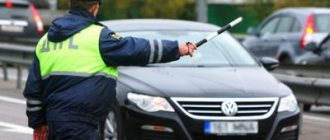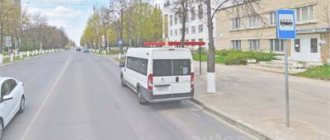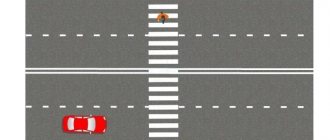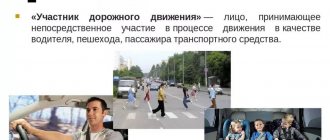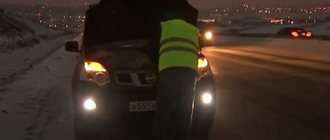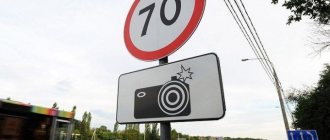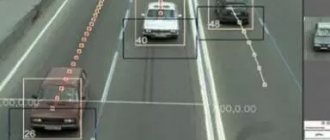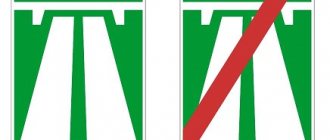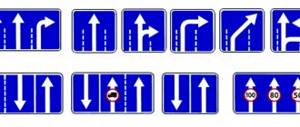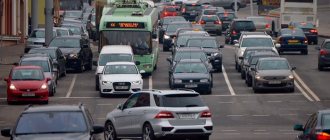Without public transport, life in cities would stop, because so many people choose buses and trolleybuses to travel. City residents often choose trams. Public transport is indispensable, so a number of points were specially introduced into the traffic rules.
They are designed to regulate movement
public vehicles and priority of route vehicles.
Route vehicles are vehicles that are used to transport people and travel along a specific route. These are trams, buses and trolleybuses, all of them move along a developed and approved route. On each route there are special places designated for transport stops.
If a vehicle deviates from the route, it ceases to be a route vehicle. For example, a driver sees a traffic jam ahead. While driving around the courtyards, he will go off the route, then the vehicle will lose its advantage.
Priority signs for route vehicles
The first advantage: a dedicated lane for route vehicles.
To designate them, use the signs 5.11, 5.13.1, 5.13.2, 5.14:
Road with a lane for route vehicles
Lane for route vehicles Entering a road with a lane for route vehicles Entering a road with a lane for route vehicles
It should be separately noted that the MTS advantage is provided only if the following conditions are met:
- public transport is located in the territory of a city or other locality;
- to indicate a stop, sign 5.16 was used.
The tram, if there is an equal right of passage, has priority over other trackless vehicles. When leaving the tram from the Depot, the tram does not have priority over other road users.
The tram does not have an advantage over other road users, since it leaves the Depot. The tram has an advantage over other road users.
Passengers are disembarked and boarded at stops marked 5.16. Traffic rules clause 18.3. states that car drivers are required to give way to public vehicles that are leaving a stop.
In turn, drivers of public vehicles must make sure that the road is clear or that the right-of-way is being given way to them, and then they can start driving.
What does this mean in practice? If public transport is leaving a stop, and at that moment an accident occurs involving a trolleybus or bus, then both people who were driving will be considered to be at fault. The fact is that the driver of the car must give way to a bus or trolleybus, because the transport starts moving from the stop. And the bus driver had to first make sure that he was allowed through, and only then start moving.
Driving in the lane for route vehicles
Only public transport can use the dedicated lane. But there are peculiarities of movement and maneuvers for other traffic participants located on the road with a lane for MTS.
Right turn
When turning, cars must change lanes into the MTS lane, and then make a turn. If the lane for route vehicles is separated by a solid marking line, then when turning, the driver of the vehicle must turn without changing lanes into the MTS lane. When leaving the road into the adjacent territory, the driver of the vehicle must first change lanes route vehicles, and then turn into the adjacent territory. When leaving the adjacent territory, the vehicle driver must first enter the lane of route vehicles, and then leave it and continue driving. In this situation, when sign 5.13.2 is installed, you are allowed to move straight, make a U-turn or turn left. This sign indicates that you are entering an intersection with a one-way road on the left side and a lane for route vehicles on the right side and thereby prohibits traffic in the opposite direction in these lanes. In this situation, when sign 5.13.1 is installed, you are allowed to move straight, make a U-turn or turn right. This sign indicates that you are entering an intersection with a one-way road on the right side and a lane for route vehicles on the left side and thereby prohibits traffic in the opposite direction in these lanes. In this situation, there is no established sign notifying us that we are entering a road with a lane for fixed-route vehicles (we will see it after completing the maneuver), but only a sign instructing us to move to the right and you must change lanes to the far right side, then change lanes for ordinary vehicles. We do not commit any violations in this case. Overtaking a vehicle in a dedicated lane for MTS is prohibited.
- Passengers can board at the right edge of the road, without interfering with route vehicles.
In Moscow, private cars are allowed to drive in a dedicated lane on weekends (Saturday and Sunday); they cannot receive a fine on these days.
- Video: Priority of route vehicles
- Conclusion
The traffic rules for public transport are described in the traffic rules. Public transport has priority when moving within the city; a dedicated lane is intended for it. Cars can only enter it in a few cases.
Priority of route vehicles
Priority of route vehicles
clause 18.1 of traffic rules . Outside intersections where tram tracks cross the roadway, the tram has priority over trackless vehicles, except when leaving the depot.
clause 18.2 of traffic rules . On roads with a lane for route vehicles, marked with signs 5.11.1, 5.13.1, 5.13.2 and 5.14, the movement and stopping of other vehicles in this lane is prohibited, with the exception of:
- school buses;
- vehicles used as passenger taxis;
- vehicles that are used to transport passengers have, with the exception of the driver's seat, more than 8 seats, the technically permissible maximum weight of which exceeds 5 tons, the list of which is approved by the executive authorities of the constituent entities of the Russian Federation - the cities. Moscow, St. Petersburg and Sevastopol;
vehicles that were used during the period from February 23 to March 14, 2019.
are transported as determined by the Government of the Krasnoyarsk Territory in agreement with the Ministry of Transport of the Russian Federation, the Ministry of Internal Affairs of the Russian Federation and the autonomous non-profit organization “Executive Directorate of the XXIX World Winter Universiade 2021 in Krasnoyarsk”
Krasnoyarsk" client groups (representatives of national university sports federations, participants in sports competitions, representatives of the International University Sports Federation (FISU), representatives of the media, technical officials, other persons taking part in the events of the XXIX World Winter Universiade 2021 in Krasnoyarsk ), in the presence of an accreditation certificate issued by the autonomous non-profit organization “Executive Directorate of the XXIX World Winter Universiade 2021 in Krasnoyarsk”.
Cyclists are allowed on lanes for fixed-route vehicles if such a lane is located on the right.
Drivers of vehicles permitted to drive in lanes for fixed-route vehicles, when entering an intersection from such a lane, may deviate from the requirements of road signs 4.1.1 - 4.1.6, 5.15.1 and 5.15.2 to continue driving along such a lane.
If this lane is separated from the rest of the roadway by a broken marking line, then when turning, vehicles must change lanes to it. It is also permitted in such places to enter this lane when entering the road and for boarding and disembarking passengers at the right edge of the roadway, provided that this does not interfere with route vehicles.
clause 18.3 of traffic regulations . In populated areas, drivers must give way to trolleybuses and buses starting from the designated stopping place. Drivers of trolleybuses and buses can start moving only after making sure that they are given way.
Full text of Chapter 18 of the Road Traffic Rules of the Russian Federation “Priority of route vehicles”
On roads with a lane for route vehicles, marked with signs 5.11.1, 5.13.1, 5.13.2 and 5.14, the movement and stopping of other vehicles in this lane is prohibited, with the exception of:
— school buses;
— vehicles used as passenger taxis;
- vehicles that are used to transport passengers, have, with the exception of the driver’s seat, more than 8 seats, the technically permissible maximum weight of which exceeds 5 tons, the list of which is approved by the executive authorities of the constituent entities of the Russian Federation - gg. Moscow, St. Petersburg and Sevastopol;
- vehicles that, during the period from February 23 to March 14, 2021, are transported as determined by the Government of the Krasnoyarsk Territory in agreement with the Ministry of Transport of the Russian Federation, the Ministry of Internal Affairs of the Russian Federation and the autonomous non-profit organization “Executive Directorate of the XXIX World Winter Universiade 2021 in the city of Krasnoyarsk” Krasnoyarsk" client groups (representatives of national university sports federations, participants in sports competitions, representatives of the International University Sports Federation (FISU), representatives of the media, technical officials, other persons taking part in the events of the XXIX World Winter Universiade 2021 in Krasnoyarsk ), in the presence of an accreditation certificate issued by the autonomous non-profit organization “Executive Directorate of the XXIX World Winter Universiade 2021 in Krasnoyarsk”.
Cyclists are allowed on lanes for fixed-route vehicles if such a lane is located on the right.
Drivers of vehicles permitted to drive in lanes for fixed-route vehicles, when entering an intersection from such a lane, may deviate from the requirements of road signs 4.1.1 - 4.1.6, 5.15.1 and 5.15.2 to continue driving along such a lane.
If this lane is separated from the rest of the roadway by a broken marking line, then when turning, vehicles must change lanes to it. It is also permitted in such places to enter this lane when entering the road and for boarding and disembarking passengers at the right edge of the roadway, provided that this does not interfere with route vehicles.
Priority of route vehicles
latest changes from January 1, 2021
18.1.
Outside intersections where tram tracks cross the roadway, the tram has priority over trackless vehicles, except when leaving the depot.
18.2.
On roads with a lane for fixed-route vehicles, marked with signs 5.11, 5.13.1, 5.13.2, 5.14, the movement and stopping of other vehicles is prohibited (except for vehicles used as a passenger taxi, as well as cyclists - if the lane for route vehicles is located on the right) in this lane, with the exception of:
- school buses;
- vehicles used as passenger taxis;
- vehicles that are used to transport passengers have, for
- excluding the driver's seat, more than 8 seats, the technically permissible maximum weight of which exceeds 5 tons, the list of which is approved by the executive authorities of the constituent entities of the Russian Federation - the cities. Moscow, St. Petersburg and Sevastopol;
- Cyclists are allowed on lanes for fixed-route vehicles if such a lane is located on the right.
- Drivers of vehicles permitted to drive in lanes for route vehicles may deviate from the requirements when entering an intersection from such a lane
- road signs 4.1.1 - 4.1.6, 5.15.1 and 5.15.2 to continue driving along such a lane.
If this lane is separated from the rest of the roadway by a broken marking line, then when turning, vehicles must change lanes to it. It is also permitted in such places to enter this lane when entering the road and for boarding and disembarking passengers at the right edge of the roadway, provided that this does not interfere with route vehicles.
18.3.
In populated areas, drivers must give way to trolleybuses and buses starting from the designated stopping place. Drivers of trolleybuses and buses can start moving only after making sure that they are given way.
Fines for non-compliance
Violation is punishable by:
- 12.17 part 1 of the Code of Administrative Offenses Failure to provide priority in movement to a route vehicle, as well as a vehicle with a blue flashing light and a special sound signal turned on at the same time - a warning or an administrative fine in the amount of 500 rubles
18.1 Outside intersections where tram tracks cross the roadway, the tram has priority over trackless vehicles, except when leaving the depot.
18.3 In populated areas, drivers must give way to trolleybuses and buses starting from the designated stopping place. Drivers of trolleybuses and buses can start moving only after making sure that they are given way.
Service for searching and paying traffic fines. You can go to the special page above or fill out the form here.
What happens if you don’t give way to a bus leaving a stop?
The usual picture: at a stop during rush hour, many buses have accumulated, the drivers of which, in turn, are trying to get onto the road and occupy a lane for movement along the route. They leave slowly, and it takes a long time due to the fact that drivers of passenger cars most often do not want to give way to buses and do not let them pass in front of them. As a result, a traffic jam forms on the road.
Valery Melnikov / RIA Novosti
Motorists who do not recognize the priority of route transport on city roads violate traffic rules.
And this point is stipulated in the traffic rules in Chapter 18 “Priority of route vehicles.”
Part 3 of this chapter states that in populated areas, drivers must give way to buses and trolleybuses starting from a designated stopping place.
Save the ordinary auto industry: why it suffers more than others
The driver of a route transport, according to the same part of Chapter 18, does not have the right to start driving until he is sure that this maneuver is safe and all drivers give way to him. So it turns out that drivers of passenger cars do not allow drivers of buses and trolleybuses to pass, and they cannot leave the stop in a timely manner. This is how a traffic jam turns out.
When a driver in a personal car does not let a bus depart from a stop, he risks getting a fine. Article 12.17 of the Code of Administrative Offenses of the Russian Federation states that failure to provide priority in traffic to a route vehicle is punishable by 500 rubles. But for the same violation, in fairness, you can receive a simple warning from a traffic police officer.
And for those drivers who not only do not like to let buses and trolleybuses pass, but also prefer to move along the lane allocated for public transport, do not forget that a fine of 1,500 rubles is provided for this violation. And in Moscow and St. Petersburg, such an offense is fined 3,000 rubles.
Not every driver knows: what advantages does a bus have when changing lanes?
Photo https://www.mosgortrans.ru
Since in densely populated megacities the authorities have the task of transferring residents from cars to public transport and freeing the city from traffic jams, drivers of shuttle buses, trolleybuses and trams have some advantages over private car owners. The AvtoVglyad portal will remind you exactly what benefits public transport has on the road.
In the Road Traffic Rules, the concept of “Route vehicle” is defined as a public bus, trolleybus and tram intended for transporting people along established routes with designated stopping places.
Dedicated lanes
Dedicated lanes are considered perhaps the main advantage of public transport. In addition to shuttle buses and trolleybuses, taxis, school buses and bicycles (when the “dedicated lane” is located on the right) can travel on these lanes. If a private owner goes there, he will be charged a fine of 1,500 rubles, and in Moscow and St. Petersburg - 3,000.
But do not forget that private cars can enter there in places with broken marking lines to exit the road, as well as to pick up and unload passengers. The main thing is that there is no interference with route vehicles.
Another advantage for drivers of public vehicles allowed to drive on dedicated lanes is the ability, in some cases, to ignore the requirements of some road signs - obligatory and prohibitive - when entering an intersection.
Starting from a stop
Another important advantage of exclusively route buses and trolleybuses is that in populated areas drivers must give way to them when they start moving from the designated stopping place (clause 18.3 of the traffic rules). In turn, public transport drivers can start moving only after they are convinced that they are given way.
Rebuilding
Many inexperienced drivers often confuse the priority of route transport when starting from a stop with changing lanes. By “changing lanes,” traffic rules mean leaving the occupied lane or occupied row while maintaining the original direction of movement.
In such cases, it is not at all necessary to give way to buses, but provided that we are not talking about leaving a stop. But when public transport, when starting to move after boarding and disembarking passengers, is forced to change lanes into the adjacent lane (for example, because of a car parked in front), then in this case the driver is obliged to give way to him.
Despite the fact that clause 18.3 of the traffic rules does not mention the word “rebuilding”.
Route vehicle
Clause 1.2 of the Traffic Regulations “General Provisions”: Route vehicle is a public vehicle (bus, trolleybus, tram) intended for transporting people on roads and moving along a set route with designated stopping places.
From this paragraph it is clear that in order for a vehicle to be considered a route vehicle, the following conditions must be met:
- the vehicle must be a bus, trolleybus or tram;
- the vehicle transports people;
- The vehicle moves along a set route with designated stopping places.
Thus, if the conditions listed in this definition are met (the minibus is a bus, carries passengers and moves along an established route), then it is certainly a route vehicle, and its driver has the right to enjoy the priority that Section 18 of the Traffic Regulations provides.
Priority of route vehicles - text of traffic rules
Route vehicles (MTS) and other traffic participants have equal rights on public roads. However, there are several exceptions to this rule when MTS have priority:
- if a separate lane is allocated for it;
- regular transport departs from the stop;
- If the rights to travel are equal, the tram always has priority, with the exception of the situation when leaving the depot.
Dedicated lanes for MTS are indicated by the following signs:
- 5.11;
- 5.14;
- 5.13.1 and 5.13.2.
